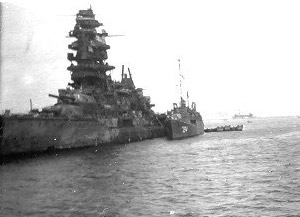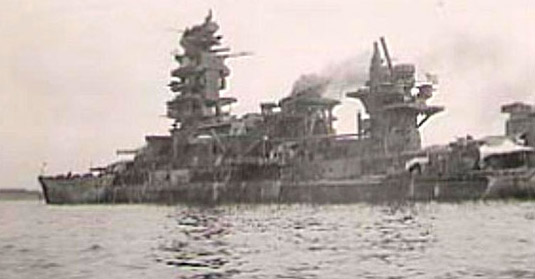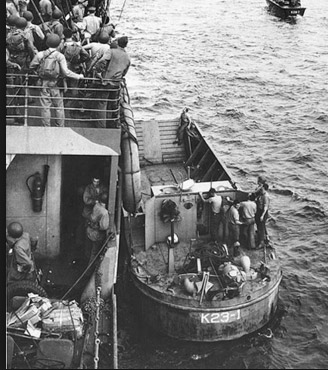Making Steam

So there it was; the day of decision was at hand.
Despite consultations with some former IJN officers, the test was going to be if we could actually raise steam and get the battleship underway. It was a great day when we did that, 11-14 April 1946. The crew of the Delta stood by her lines to cast off if we got the engines started and couldn’t stop them. There was scarcely a quiver as the wheels turned over; they stopped, reversed, and stopped again without any fuss. But would they operate on days on end, could we steer, could we handle the ship? There was only one way to find out. We prepared for a trial run, moving all the crew aboard, set up our own galley with old Army equipment, trained the crew in navigational duties, perfected the ship’s organization. Four colonels from General MacArthur’s staff came out the night before to go with us.
Luckily it was a balmy spring-like day with little wind. We were to cast off at ten. The boatswain was on the buoy ready to knock out the pin; the crew of the Delta was standing by with the lines singled up. At 0955 we lost an electric generator without which we could not steer. Wait.
As we waited, tension on the Delta rose until it became unstoppable. Her captain was jumping up and down in the wings of the bridge, shouting at people. Something had to be done. They cast off and stood out of the bay, ladders dragging over the side and boats trailing from the booms. It looked for all the world as if she finally had enough and was going home. The hell with it!
We sat alone at the buoy. 1030, 1045, 1100. The crew of the Nagato was not impatient. We were too tired for that. Besides, everyone was confident that the electricians could make repairs. At 1145, they reported ready to steer, and Captain Whipple gave the signal to the boatswain. The pin was knocked out, parting us from the mooring buoy still hidden under the flair of the bow.
Starboard engines ahead one-third! Nothing happened. The engine room reported that the starboard engine was going ahead one-third. Still nothing. Sighting back over that stern against the hills. I was able to convince myself that our stern was swinging slowly to port. The, after waiting anxious minutes we saw the edge of the buoy coming out from under the port bow. There was no doubt about it – she was moving. All engines ahead two-thirds!
We began to lurch out through the shipping in the outer harbor. All decks were lined by sailors, some of them clicking cameras and others sitting atop boats and boat booms. I had to admire Captain Whipple. Standing easily in the port wing of the bridge, he was evidently enjoying himself, though he knew better than anyone else that if we had steering or engine failure, as was likely, we would certainly hit one of the ships and his naval career would be definitely clouded.

(Nagato raises steam on her own, Yokosuka harbor, 1946).
We looked down on several decks that passed by, but we touched nothing. Before we were clear of the shipping, there was a casualty to the rudder signal indicator gauge. The helmsman could no longer be sure what the rudders, six hundred long feet away, were doing. We fixed that by putting a man in the steering engine room where he could talk through a speaking tube to a man who was on the phone to the coming tower to tell them where the rudders were pointing. I had just got topside from that, when the word came that the port condenser had lost vacuum.
Before that was fixed, there was a report that the cooling water to the refrigerating plant had warmed to one hundred fifty degrees at the intake We had six thousand dollars’ worth of meat in the icebox, which would spoil unless notion as quickly taken. As we were cooling salt water, it had always been assumed that it came from outside the ship.
That day we found out it actually came from a tank next to the boilers. After that defect was remedied I got back to the bridge to find out we were well out of the channel. Hellcats for the Marine Air Base were making practice dives on us. I had just got some K-Rations broken out for the colonels when we blew a tube in Number Four boiler and had to drop down to six knots.
Number Six boiler lost its fires when salt water was pumped in from a tank supposed to contain oil. I went back on the fantail to see how the Colonels were doing on their temporary duties away from the General Headquarters of the Occupation in the Dai Ichi Insurance Company Building in Tokyo.
They were sunning themselves.
Looking over the stern I could see that the screws were still turning over, ruffling the surface of the water with those minor upheavals one associates with rocks in the bed of a stream. I thought the Nagato was finished, and would wind up lying dead in the water right there until boats came out to take off the crew. Then I wondered what my next assignment might be.
That was all reckoning without the determination of a green crew of American engineers. Number Six was brought back on the line. Nagato made a wide circle in the lower bay and headed for the anchorage. I went down to the engine room to see how things were going. The control booth was brilliantly illuminated. The Chief was sitting there on a bench, barely able to keep awake. The throttlemen, stripped to their waists and glistening with sweat, had their eyes on the revolution counters.
Rods geared directly to the propeller shafts came in through the floor of the control booth, feeding data into the indicators. Each shaft was making seventy turns per minute. The needles showing steam chest pressures were creeping up. All the markings were in Japanese, of course, but by this time we had become used to them.
Tired though I know the men to be, I left the booth convinced that we could take her anywhere. Back on the bridge, I found that we were near then anchorage. The hook went down without further incident.
Anchored outside the breakwater, we found ourselves in a different world. One could no longer go to the Delta for a hot bath and clean clothes, nor borrow a missing tool from her machine shop. There was an emerging struggle with the boat pool people. We never had enough boats, and it became a campaign just to get ashore. But most of all, we had to contend with the sea. Great slopes came sloping along the ship’s sides, carrying away everything in their path.
Our major preoccupation was now to get the ship to sea and sail for a warmer climate. Besides training the crew, making sure each one understood his duties, we had to sweep out the ship, getting rid of many tons of materials including bedding, matting, furniture, scrap lumber and just plain old trash that had piled up since she was a working ship.
For this purpose we had nearly a hundred Japanese laborers aboard almost every day. They were as much a part of life in the Nagato at that time as the view and the weather: ubiquitous. Most were in their teens with a sprinkling of older men. All wore the lumpy Japanese military cap with mustard-colored uniforms, and black, split-toed slippers. As they hauled up a cargo net from a boat to the fantail they looked as if they had all been shaken up in a dustbin and dumped on deck, shapeless, dingy little men, who at first glance all appeared alike.
Their foreman would form them up in lines while our men counted off work parties in much the same spirit as they would have selected cabbages in a grocery store.
Then, with admonitory “hubba! hubba’s!” the Bluejackets would take the Japs into to the bowels of the ship, to lead them out a few minutes later laden with trash. For some reason the Japanese had a horror of spaces below the water line; they would prostrate themselves most abjectly on the deck, but of course they still had to go down. At noon, they had an hour for lunch that they ate with chopsticks, squatting on the fantail. They bought out a mixture of rice and fish in wooden bento boxes, which apparently are their equivalent of lunch pales. Then, back to work until well into the afternoon when we searched them and sent them back to the beach in a tank lighter.

There were more slackers and thieves among them, but by and large they were good workmen, anxious to do the best they could. One went crazy on the deck, apparently a case of combat fatigue, but this was the only show of resentment we had. That they were not sorry for themselves, as Europeans are, was proved one stormy day when we loaded them into the tank lighter. The boat would rise to the levels of the deck on heavy swells, then sink into the troughs, now battering against the ship’s side, now straining out away from the cargo net.
The Japanese climbing into the net became drenched with sheets of icy spray. I could not see how we could get them over in the failing daylight without crushing one at least against the side, but it was out of the question to keep them overnight. Some watched their chance and made it nimbly enough but others – army people, no doubt – were terrified on the net and clung to it paralyzed with fear. They got no sympathy from those already in the tank lighter.
“Come on you dumb cluck!” they shouted. A few older men gathered aft, plucking the dazed ones off the net as the lighter surged upward, and then flung them down to the tank-deck to make room for more. No one was hurt, thank God, but that was a graphic reminder of the raw power of the sea. It is never to be trifled with.
Never. And that is exactly what we were about to do in Nagato.
Copyright 2015 Vic Socotra
www.vicsocotra.com
Twitter: @jayare303
